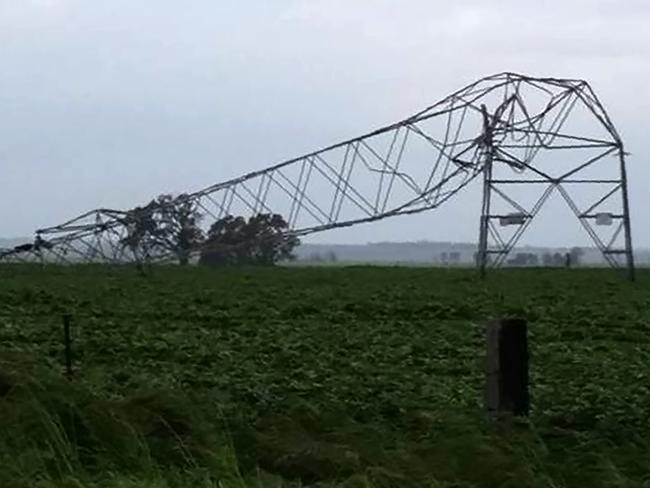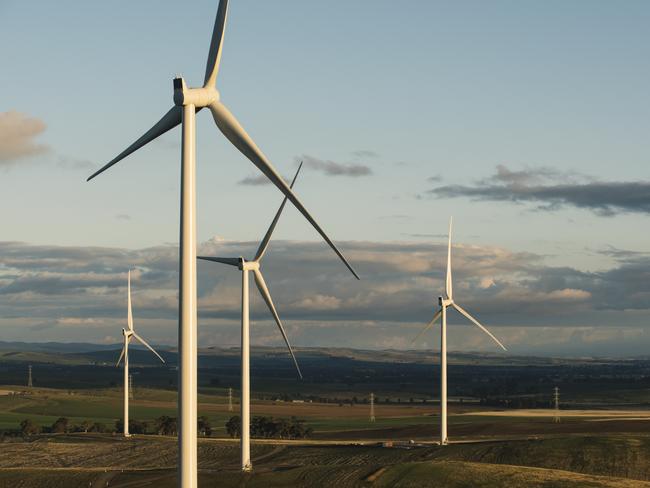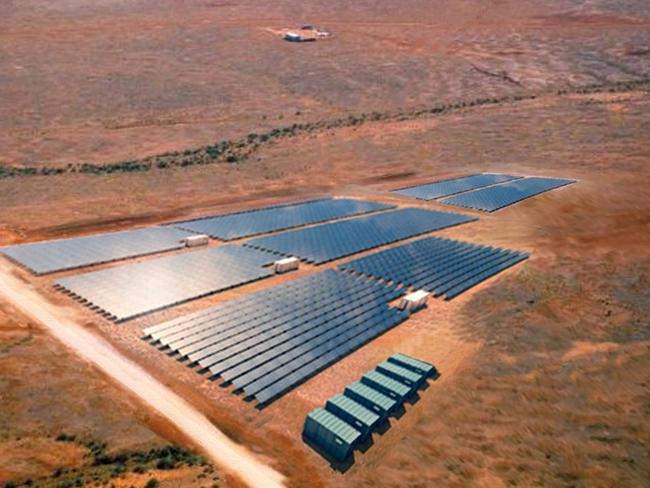Can we rely on renewables?
WHEN an entire state went dark last week, rightly or wrongly, people started questioning whether renewables were reliable.

WHEN an entire state went dark last week, rightly or wrongly, people started questioning whether renewables were reliable.
The huge storm that swept through South Australia produced a tornado and brought down 23 transmission towers eventually leading to the blackout last week.
While it’s been acknowledged that the one-in-50-year storm was the main reason the lights went out, it’s led to questions about whether the state’s reliance on wind farms made any difference to whether the blackout would have occurred.
A preliminary report from Australian Energy Market Operator released this week seemed to raise more questions as it found there was a drop in electricity being generated from six wind farms in the seconds before the blackout.
So does this mean we can’t rely on renewables for our future electricity needs?
THE BLAME GAME
The truth is we don’t yet know why the blackout happened. The best we know (from AEMO’s report) is that an extremely large storm caused three major transmission lines north of Adelaide to fail and there were “significant voltage dips and loss of load”.
About 315MW of wind power disconnected from the system in the seconds before the blackout but it’s unclear why this happened.
To make up the shortfall, the network tried to get more power via the Heywood interconnector, which provides SA with electricity from Victoria. But this caused the interconnector to overload and cut off the power in SA in order to protect the interconnector from being damaged.
Power returned to most of Adelaide within hours but some regional areas were blacked out for more than a day.

RENEWABLES NOT AT FAULT
The South Australian government maintains the blanket blackout was caused by the last week’s storms and not the state’s reliance on wind and solar energy for 40 per cent of its power.
South Australia Energy Minister Tom Koutsantonis said an outdated national energy market was preventing the transition to clean energy.
He also told ABC on Friday there may have been an issue with how some of the wind farms’ hardware or software operated.
“They weren’t able to take a certain number of voltage drops,” he told ABC on Friday morning, referring to the six wind farms that reported loss of load ahead of the blackout.
“There’s something about these (six) wind farms, the way they were installed that caused an issue and that is being sorted out.”
He pointed out that fixing this type of equipment issue was very different to placing the blame on renewables for only producing “intermittent energy”.
RELIABLE ENOUGH?
One of the big criticisms of renewables is that they provide “intermittent energy” because they only generate electricity when the sun is shining, or the wind is blowing, for example.
Federal Energy Minister Josh Frydenberg said the blackout last week had brought up broader issues about the reliability of intermittent energy.
“We saw in South Australia a disaster,” Mr Frydenberg said following an emergency COAG energy meeting with state representatives to discuss the blackout.
“The lights went out. It’s critically important we don’t see that again, whether in South Australia or elsewhere.”
He announced on Friday that Australia’s chief scientist Dr Alan Finkel would chair an independent review of Australia’s energy security. A preliminary report will be prepared ahead of the next COAG meeting in December.
Intermittent energy is a problem for an electricity network because it likes “synchronous supply” where supply and demand is kept at a perfect level.

If wind power drops off, the network needs to get extra electricity from somewhere else to meet supply. In SA’s case this would normally come from its gas-fired power plants, solar or the interconnectors that provide extra electricity from Victoria.
But the blackout happened because the interconnector wasn’t designed to provide that much extra electricity, causing it to overload and the system to shut down.
While it’s debatable whether renewables had a role in the blackout, some believe its “intermittent” nature may have made it harder to get the system back online.
The wind farms could not be used initially to help get the electricity running again because of how variable their supply was. Eventually the gas-fired Torrens Island Power Station was used to reconnect SA’s power.
Most experts believe it’s too early to tell who’s to blame and what lessons need to be learnt from the blackout. But there are some “big questions” about why the system did not work as it was designed to do.
“Lots of the backups that are meant to operate in the National Electricity Market didn’t work,” Economist Ross Garnaut told reporters in Adelaide on Thursday. “It’s not a satisfactory situation.”
He said South Australians pay millions of dollars a year to utilities for “black start” systems that are supposed to return power to the grid quickly.
Dr Finkel tentatively agreed. “You probably could argue the system didn’t perform ideally in terms of the rapidity with which it was recovered,” he said.
But he said it wasn’t clear yet whether this was related to renewables, as six thermal generators may also have disconnected, if put in the same situation.
100 PER CENT IS POSSIBLE
Associate Professor Mark Diesendorf is part of a team at the University of NSW that’s analysing how Australia’s National Electricity Network could cope with 100 per cent renewables and believes it is possible.
But he said there needed to be a greater mix of different types of renewable energy sources to make the system stable.
For example, Prof Diesendorf believes a solar thermal power station should be built in SA at Port Augusta, which would provide more control over supply because it’s possible to store solar energy as heat in tanks of molten salt.
The state should also look at pumped hydro, which would involve using excess wind power to pump sea water up to a reservoir built at the top of a nearby hill. This water could be released to produce hydro energy when extra electricity was needed at peak times.

“South Australia could go to 100 per cent renewables if they got concentrated solar thermal with storage and sea water pumped hydro,” Prof Diesendorf told news.com.au.
“South Australia has that potential given the right mix and perhaps optionally assisted by a transmission line. That would be a very stable system.”
There was also the possibility of transitioning to a “smart grid” during a storm, which would manage demand. For example electricity going to aluminium smelters or other power-hungry industry could be cut-off for a short time (maybe up to an hour) to reduce demand.
“This would not damage the smelting process,” he said.
If there was strong political will, Prof Diesendorf said Australia could get most of its electricity from renewables in something like 20 years.
SOUTH AUSTRALIA V TASMANIA?
With the rising popularity of renewables there has been talk of building more connections into the National Electricity Market to improve stability.
South Australia currently has an interconnector with Victoria but has already flagged that it wants to build another one to NSW.
Premier Jay Weatherill has previously said he hoped this would bring down electricity prices in South Australia, which were often the highest in Australia, and would also open up the possibilities for the state’s renewable energy to be shipped to other states.
Prof Diesendorf said it made sense for a state like South Australia to invest in renewables.
“Some states have more renewable energy potential and South Australia is the most blessed of any states on the mainland,” he said.
“It has wind and solar potential but limited demand,” he said. “So it makes sense to build more renewable energy and an additional interconnector so electricity can be fed into areas of greater demand in NSW, Victoria and ultimately Queensland.
“There’s no logical reason why each state should have the same target.”

SA Energy Minister Tom Koutsantonis told ABC on Friday there needed to be a greater level of interconnection around Australia so there was a truly national market and the investment for renewables could go where resources like wind and sun were plentiful.
“The reason there’s so much investment in South Australia for renewable energy is because we have the resource,” Mr Koutsantonis said.
NSW Energy Minister Anthony Roberts this week backed the new interconnector, saying it would boost competition while also improving energy security. The COAG energy council last month agreed to fast track testing.
SA’s not the only one with an eye to being Australia’s renewable powerhouse. Tasmania also wants $1 billion to build a second Bass Strait cable to deliver more electricity to the mainland. It has high-quality wind as well as hydro that can provide base-load renewables.
Tasmania’s ambitious plan comes just months after the state was forced to spend scores of millions of dollars to bring in diesel and gas generators to keep its own lights on.
Low rainfall left Tasmania’s hydro dam levels dwindling and the existing Bass Strait cable was damaged and inoperable, plunging the island into an energy crisis.
With dams now brimming and the interconnector repaired, State energy minister Matthew Groom is full of confidence.
“We will be advocating for Tasmania playing an even more significant role than we have in the past to assist mainland Australia to transition to renewable energy,” he said on Thursday.
SCORING CHEAP POINTS?
The Federal Government has also used the blackout to push for a national renewable energy target, which Opposition Leader Bill Shorten says is just cheap political point scoring.
Both the Prime Minister Malcolm Turnbull and Federal Energy Minister Josh Frydenberg have criticised some states for setting “unrealistic targets” on boosting renewable energy.
Mr Frydenberg said states, territories and the federal government needed to co-operate to “harmonise” renewable energy targets.
“We want reliable and affordable energy supply as we transition to a lower emissions future,” Mr Frydenberg said on Thursday. “But at all times energy security is paramount.”
Mr Koutsantonis has said South Australia’s renewable energy target was just an aspiration and the only incentive to build more wind or solar came from the federal government’s renewable energy target and the renewable energy certificates it handed out.
“There’s no mechanism behind South Australia’s renewable energy target,” he said.
Currently Australia plans to lift its renewable energy from 15 per cent now to 23.5 per cent by 2020. In comparison, South Australia wants to lift its share of renewables from 41 per cent to 50 per cent by 2025.
Fellow Labor governments have similarly ambitious targets. Queensland plans to go from 7 per cent renewable energy now to 50 per cent by 2030, while Victoria wants to go from 12 per cent to 40 per cent by 2025.
Meanwhile the Liberal government in NSW has a more modest target of increasing its reliance on renewables from 14 per cent to 20 per cent by 2020.
Economist and former Liberal Party leader John Hewson hoped politicians would stop squabbling over the blackout and look forward rather than back.
“I hope that we can get the politics, if you like, out of this and just focus on the issues,” Dr Hewson said. “Why did it happen? Why weren’t we better prepared? What could’ve been done to fire it up quicker?”
— With AAP



